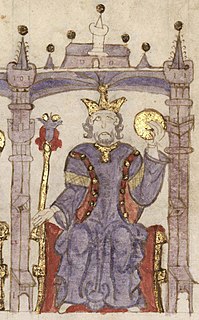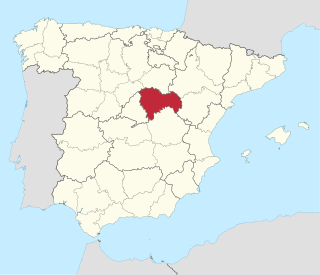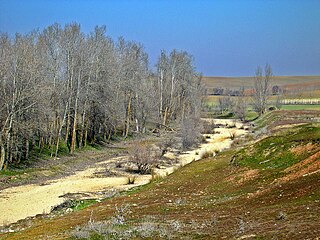
Rodrigo Díaz de Vivar was a Castilian knight and warlord in medieval Spain. Fighting with both Christian and Muslim armies during his lifetime, he earned the Arabic honorific al-sīd, which would evolve into El Cid, and the Spanish moniker El Campeador. He was born in Vivar, a village near the city of Burgos. As the head of his loyal knights, he came to dominate the Levante of the Iberian Peninsula at the end of the 11th century. He reclaimed the Taifa of Valencia from Moorish control for a brief period during the Reconquista, ruling the principality as its Prince from 17 June 1094 until his death in 1099. His wife, Jimena Díaz, inherited the city and maintained it until 1102 when it was reconquered by the Moors.
Castile or Castille is a territory of imprecise limits located in Spain. Its extension is often ascribed to the sum of the regions of Old Castile and New Castile, as they were formally defined in the 1833 territorial division of Spain. Those two regions cover the following modern autonomous communities: the eastern part of Castile and León, Castile-La Mancha, and Community of Madrid as well as Cantabria and La Rioja. However, it has been pointed out that in practice the modern limits of Castile are imprecise, and that this name has been used mainly as a reference for the image of Spain as a nation.

Burgos is a city of Spain located in the autonomous community of Castile and León. It is the capital and most populated municipality of the province of Burgos.

Castile and León is an autonomous community in northwestern Spain.

Alfonso IV, called the Monk, was King of León from 925 and King of Galicia from 929, until he abdicated in 931.

Guadalajara is a province of Spain, belonging to the autonomous community of Castilla–La Mancha. As of 2013 it had a population of 257,723 people. The population of the province has grown in the last 10 years. It is located in the centre of the Iberian Peninsula.

Palencia is a city of Spain located in the autonomous community of Castile and León. It is the capital and most populated municipality of the province of Palencia.

Urraca of Portugal was the queen of León from 1165 until 1171 or 1172 as the wife of King Ferdinand II. She was the daughter of the first Portuguese king, Afonso I, and the mother of Alfonso IX. After her marriage to Ferdinand was annulled, the former queen became a nun.

The Trabancos is a river in Spain that flows between the Zapardiel and the Guareña rivers, and is a tributary of the Duero river. The source of the Trabancos is in Moraña, a region in the north of the province of Ávila, near Blascomillán. The Trabancos is at an elevation of approximately 1,100 metres (3,600 ft), is approximately 85 kilometres (53 mi) long and, although its river bed is stable, only has a constant water flow during and immediately after torrential rains.

The Laws of the Indies are the entire body of laws issued by the Spanish Crown for the American and the Asian possessions of its empire. They regulated social, political, religious, and economic life in these areas. The laws are composed of myriad decrees issued over the centuries and the important laws of the 16th century, which attempted to regulate the interactions between the settlers and natives, such as the Laws of Burgos (1512) and the New Laws (1542). Throughout the 400 years of Spanish presence in these parts of the world, the laws were compiled several times, most notably in 1680 under Charles II in the Recopilación de las Leyes de los Reynos de las Indias. This became considered the classic collection of the laws, although later laws superseded parts of it, and other compilations were issued.

The designation artede (la) repoblación was first proposed by José Camón Aznar in 1949 to replace the term Mozarabic as applied to certain works of architecture from the Christian kingdoms of northern Spain between the end of the 9th and beginning of the 11th centuries. Camón argued that these buildings were related stylistically to the architecture of Asturias and owed little to Andalusian styles. Moreover, since they were built by Christians living under Christian rule, neither were they Mozarabic.

Arévalo is a municipality in Spain, it is situated in the province of Ávila and is part of the autonomous community of Castile and León. The name came from the Celtic word arevalon, meaning "place near the wall."

Tubilla del Agua is a village and municipality located in the province of Burgos, Castile and León, Spain. According to the 2004 census (INE), the municipality has a population of 209 inhabitants. The climate is relatively cool in the summer and cold in the winter.

The Treviño Enclave in northern Spain is part of the territory of the province of Burgos, but is completely surrounded by the territory of the Basque Country province of Álava. Thus, it is an enclave of the Basque Country and an exclave of Castile and León. It consists of two municipalities—Condado de Treviño and La Puebla de Arganzón—and is part of the Judicial district of Miranda de Ebro in the province of Burgos.

Pedro Fernández de Castro "the Castilian" was a Castilian nobleman, son of Fernando Rodríguez de Castro and Estefanía Alfonso la Desdichada. He inherited the Infantazgo of León from his parents and was mayordomo mayor of Fernando II and his son Alfonso IX of León.

The Monastery of San Salvador was a Benedictine monastery in the town of Oña, in the province of Burgos, central Spain, founded in 1011, which lasted until the 19th century.
Julio Valdeón Baruque was a historian of Spain.

Valdecañas de Cerrato is a town and a district in the municipality of Baltanás. It is located 9 km from Baltanás in the comarca of El Cerrato (Palencia), in the autonomous community of Castile and León (Spain), and belongs to the jurisdiction of Palencia.
The Regionalist Unity of Castile and León is a "regionalist, democratic, modern and innovative political party that, focusing on the principles of freedom, justice and solidarity, assumes the uncompromising defense of the legitimate interests of Castile and León."

The historic centre of Pontevedra (Spain) is the oldest part of the city. It is the second most important old town in Galicia after Santiago de Compostela, ·, and was declared a historic-artistic complex on 23 February 1951.
















